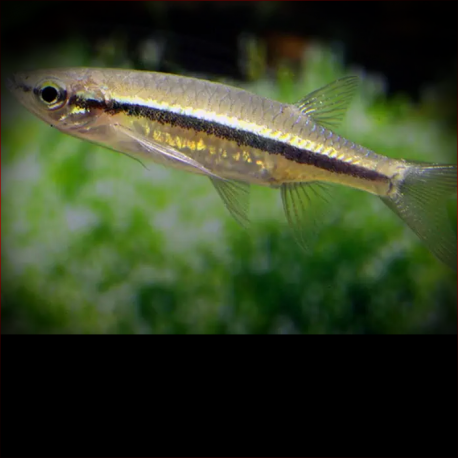Esomus Danrica
Cypriniformes Print
More info
Datasheet
| Minimum Tank Size | 160 litres / 42.27 US gallons |
| Maximum Size | 7.0cm / 2.76inches |
| Temperature | 20°C / 68.00°F - 26°C / 78.80°F |
| Hardness | 1.01dgH / 18ppm - 12.05dgH / 215ppm |
| pH | 6.0-8.0 |
General Description
The Esomus Danrica, commonly known as the Flying Barb, belongs to the Cyprinidae family. This species is characterized by greatly-enlarged pectoral fins and two pairs of barbels, with the maxillary pair being extremely long and usually reaching the pectoral fins. It has a maximum size of 7.0cm and is found in various habitats, showing a preference for shallow, slow-moving waters with dense aquatic vegetation.
Aquarium Setup
The Esomus Danrica thrives in a well-planted tank with a dark substrate and benefits from the addition of floating plants, driftwood roots, or branches to diffuse light. Water movement should be gentle as the species originates from sluggish waters. It is essential to maintain stable water conditions within the parameters of hardness (18-215ppm), pH (6.0-8.0), and temperature (20-26°C). This fish is prone to jumping, so a secure cover is necessary to prevent escapes.
Behaviour
This species exhibits a hierarchical pecking order within a group, necessitating maintenance in numbers of eight or more to prevent incessant bullying of weaker individuals. While reasonably gregarious, the Flying Barb is a shoaling fish rather than a schooling one. Aggressive behaviors, such as fin-nipping, may surface, particularly if kept in insufficient numbers or with slow-moving or long-finned species.
Feeding and Diet
In its natural environment, the Flying Barb feeds on terrestrial and aquatic invertebrates and their larvae. In an aquarium setting, it readily accepts appropriately sized dried foods but should also be offered live and frozen varieties such as Daphnia, Artemia, and chironomid larvae (bloodworm) regularly to ensure a balanced diet.
Reproduction & Dimorphism
Information regarding the reproduction of the Esomus Danrica is currently unreported. Adult males of this species are typically slimmer and slightly smaller than females, exhibiting sexual dimorphism in physical characteristics.
Habitat and Distribution
The Flying Barb is widely distributed across parts of Pakistan, Nepal, Myanmar, Bangladesh, India, and Sri Lanka. It displays a marked preference for shallow, slow-moving waters with abundant aquatic vegetation, including rice paddies and temporally-inundated environments, while also being found in semi-polluted canals and small streams.

